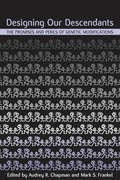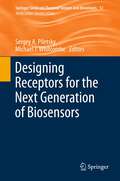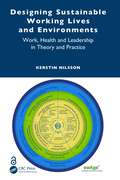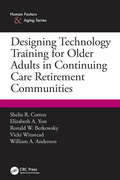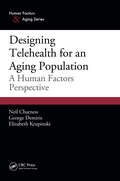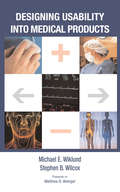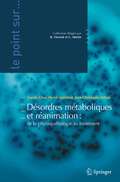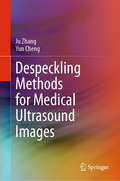- Table View
- List View
Designing Luxury Brands: The Science of Pleasing Customers’ Senses (Management for Professionals)
by Diana DervalThis book shows how to build successful luxury brands using the power of sensory science and neuro-physiology. The author introduces – based on inspiring business cases like Tesla, Louis Vuitton, Chanel, Hermès, Moncler, Louboutin, or Sofitel in industries such as Fashion, Automotive or Leisure – groundbreaking scientific methods - like the Derval Color Test® taken by over 10 million people - to predict luxury shoppers’ preferences and purchasing patterns and illustrates common and unique features of successful luxury brands. Through various practical examples and experiments, readers will be able to build, revamp, or expand luxury brands and look at luxury from a new angle.
Designing Microwave Sensors for Glucose Concentration Detection in Aqueous and Biological Solutions: Towards Non-invasive Glucose Sensing (Springer Theses)
by Carlos G. JuanThis book presents a comprehensive study covering the design and application of microwave sensors for glucose concentration detection, with a special focus on glucose concentration tracking in watery and biological solutions. This book is based on the idea that changes in the glucose concentration provoke variations in the dielectric permittivity of the medium. Sensors whose electrical response is sensitive to the dielectric permittivity of the surrounding media should be able to perform as glucose concentration trackers. At first, this book offers an in-depth study of the dielectric permittivity of water–glucose solutions at concentrations relevant for diabetes purposes; in turn, it presents guidelines for designing suitable microwave resonators, which are then tested in both water–glucose solutions and multi-component human blood plasma solutions for their detection ability and sensitivities. Finally, a portable version is developed and tested on a large number of individuals in a real clinical scenario. All in all, the book reports on a comprehensive study on glucose monitoring devices based on microwave sensors. It covers in depth the theoretical background, provides extensive design guidelines to maximize sensitivity, and validates a portable device for applications in clinical settings.
Designing Our Descendants: The Promises and Perils of Genetic Modifications
by Audrey R. Chapman Mark S. FrankelThe Human Genome Project, discoveries in molecular biology, and new reproductive technologies have advanced our understanding of how genetic science may be used to treat persons with genetic disorders. Greater knowledge may also make possible genetic interventions to "enhance" normal human characteristics, such as height, hair or eye color, strength, or memory, as well as the transmittal of such modifications to future generations. The prospect of inheritable genetic modifications, or IGMs, whether for therapeutic or enhancement purposes, raises complex scientific, ethical, and regulatory issues. Designing Our Descendants presents twenty essays by physicians, scientists, philosophers, theologians, lawyers, and policy analysts addressing these issues from diverse perspectives. In three sections, the authors discuss the short- and long-term scientific feasibility of IGM technology; ethical and religious issues related to safety, justice, morality, reproductive rights, and enhancement; and regulatory issues including the necessity of public input and oversight and the influence of commercialization. Their goal is to open a dialogue engaging not only scholars and scientists but also government officials and concerned citizens. The authors conclude that while IGM cannot be carried out safely and responsibly on humans utilizing current methods, it is important to begin public discussion now to determine whether, and if so how, to proceed.
Designing Receptors for the Next Generation of Biosensors (Springer Series on Chemical Sensors and Biosensors #12)
by Sergey A. Piletsky and Michael J. WhitcombeDespite achievements in the application of enzymes, antibodies and biological receptors to diagnostics and sensing, the last two decades have also witnessed the emergence of a number of alternative technologies based on synthetic chemistry. This volume shows how synthetic receptors can be designed with characteristics that make them attractive alternatives to biological molecules in the sensory and diagnostics fields, with contributions from leading experts in the area. Subjects covered include synthetic receptors for a range of biomolecules, the use of antimicrobial peptides for the detection of pathogenic microorganisms, the development of molecularly imprinted polymer (MIP) nanoparticles, the in silico design of MIPs and MIP-based sensors, and two chapters examining the development of sensors from an industrial point of view. The particular focus of all chapters is on practical aspects, either in the development process or the applications of the synthesized materials. This book will serve as an important reference work for business leaders and technology experts in the sensors and diagnostics sector.
Designing Science Presentations: A Visual Guide to Figures, Papers, Slides, Posters, and More
by Matt CarterDesigning Science Presentations: A Visual Guide to Figures, Papers, Slides, Posters, and More, Second Edition, guides scientists of any discipline in the design of compelling science communication. Most scientists never receive formal training in the design, delivery and evaluation of scientific communication, yet these skills are essential for publishing in high-quality journals, soliciting funding, attracting lab personnel, and advancing a career. This clear, readable volume fills that gap, providing visually intensive guidance at every step—from the construction of original figures to the presentation and delivery of those figures in papers, slideshows, posters and websites. The book provides pragmatic advice on the preparation and delivery of exceptional scientific presentations and demonstrates hundreds of visually striking presentation techniques.Features clear headings for each section, indicating its message with graphic illustrationsProvides clear and concise explanations of design principles traditionally taught in design or visualization coursesIncludes examples of high-quality figures, page layouts, slides, posters and webpages to aid readers in creating their own presentationsIncludes numerous "before and after" examples to illustrate the contrast between poor and outstanding presentations
Designing Sustainable Working Lives and Environments: Work, Health and Leadership in Theory and Practice
by Kerstin NilssonWork is central to people’s lives and the course of their life. The opportunities and chances an individual can have in their life are significantly connected to work. Individuals' work is also crucial for organisations, companies and for the whole of society. There is a constant need to make changes and readjustments of working life since these can deeply affect the individual and their employability. To make working lives more healthy, sustainable and attractive, being aware of the measures and changes that can be achieved in practice is of crucial importance. This book bridges the gap between the theories and explanatory models offered in research and actual work environments and workplaces.This book constitutes a theoretical framework that visualises the complexity of working life and increases the knowledge and awareness of individuals, companies, organisations and society regarding different factors and patterns. It aims to support individual reflections and joint discussions into daily operations on the individual, organisational and societal level. This book contains practical tools to use in daily working life that analyse possible risks in the work environment when planning measures and actions for health promotion. These practical tools are derived from the four spheres for action and employability in the SwAge model. Developed by the author, the SwAge model (Sustainable Working Life for All Ages) is a theoretical, explanatory model that explains the complexity of creating a healthy and sustainable working life for all ages. By using the SwAge model as a comprehensible framework, the reader will be able to visualise the complexity of factors that affect and influence whether people are able to and want to participate in working life and in the work environment, thereby contributing to increased employability.Designing Sustainable Working Lives and Environments is an essential read for students, researchers, work environment engineers, ergonomics and human factor specialists, occupational health and safety practitioners, business managers, HR staff, leadership decision-makers and labour union professionals.The Open Access version of this book, available at http://www.taylorfrancis.com, has been made available under a Creative Commons Creative Commons Attribution (CC-BY) 4.0 license
Designing Sustainable Working Lives and Environments: Work, Health and Leadership in Theory and Practice
by Kerstin NilssonWork is central to people’s lives and the course of their life. The opportunities and chances an individual can have in their life are significantly connected to work. Individuals' work is also crucial for organisations, companies and for the whole of society. There is a constant need to make changes and readjustments of working life since these can deeply affect the individual and their employability. To make working lives more healthy, sustainable and attractive, being aware of the measures and changes that can be achieved in practice is of crucial importance. This book bridges the gap between the theories and explanatory models offered in research and actual work environments and workplaces.This book constitutes a theoretical framework that visualises the complexity of working life and increases the knowledge and awareness of individuals, companies, organisations and society regarding different factors and patterns. It aims to support individual reflections and joint discussions into daily operations on the individual, organisational and societal level. This book contains practical tools to use in daily working life that analyse possible risks in the work environment when planning measures and actions for health promotion. These practical tools are derived from the four spheres for action and employability in the SwAge model. Developed by the author, the SwAge model (Sustainable Working Life for All Ages) is a theoretical, explanatory model that explains the complexity of creating a healthy and sustainable working life for all ages. By using the SwAge model as a comprehensible framework, the reader will be able to visualise the complexity of factors that affect and influence whether people are able to and want to participate in working life and in the work environment, thereby contributing to increased employability.Designing Sustainable Working Lives and Environments is an essential read for students, researchers, work environment engineers, ergonomics and human factor specialists, occupational health and safety practitioners, business managers, HR staff, leadership decision-makers and labour union professionals.The Open Access version of this book, available at http://www.taylorfrancis.com, has been made available under a Creative Commons Creative Commons Attribution (CC-BY) 4.0 license
Designing Technology Training for Older Adults in Continuing Care Retirement Communities
by Shelia R. Cotten Elizabeth A. Yost Ronald W. Berkowsky Vicki Winstead William A. AndersonThis book provides the latest research and design-based recommendations for how to design and implement a technology training program for older adults in Continuing Care Retirement Communities (CCRCs). The approach in the book concentrates on providing useful best practices for CCRC owners, CEOs, activity directors, as well as practitioners and system designers working with older adults to enhance their quality of life. Educators studying older adults will also find this book useful Although the guidelines are couched in the context of CCRCs, the book will have broader-based implications for training older adults on how to use computers, tablets, and other technologies.
Designing Technology Training for Older Adults in Continuing Care Retirement Communities
by Shelia R. Cotten Elizabeth A. Yost Ronald W. Berkowsky Vicki Winstead William A. AndersonThis book provides the latest research and design-based recommendations for how to design and implement a technology training program for older adults in Continuing Care Retirement Communities (CCRCs). The approach in the book concentrates on providing useful best practices for CCRC owners, CEOs, activity directors, as well as practitioners and system designers working with older adults to enhance their quality of life. Educators studying older adults will also find this book useful Although the guidelines are couched in the context of CCRCs, the book will have broader-based implications for training older adults on how to use computers, tablets, and other technologies.
Designing Telehealth for an Aging Population: A Human Factors Perspective
by George Demiris Neil Charness Elizabeth KrupinskiAs simple and straightforward as two health professionals conferring over the telephone or as complex and sophisticated as robotic surgery between facilities at different ends of the globe, telehealth is an increasingly frequent component in healthcare. A primer on the human factors issues that can influence how older adults interact with telehealt
Designing Usability into Medical Products
by Michael E. Wiklund Stephen B. WilcoxAdvocating a user-centered approach to medical technology design, Designing Usability into Medical Products covers the essential processes and specific techniques necessary to produce safe, effective, usable, and appealing medical systems and products. Written by experts on user-centered research, design, and evaluation, the book provides a range o
Designing User Interfaces for an Aging Population: Towards Universal Design
by Jeff Johnson Kate FinnDesigning User Interfaces for an Aging Population: Towards Universal Design presents age-friendly design guidelines that are well-established, agreed-upon, research-based, actionable, and applicable across a variety of modern technology platforms. The book offers guidance for product engineers, designers, or students who want to produce technological products and online services that can be easily and successfully used by older adults and other populations. It presents typical age-related characteristics, addressing vision and visual design, hand-eye coordination and ergonomics, hearing and sound, speech and comprehension, navigation, focus, cognition, attention, learning, memory, content and writing, attitude and affect, and general accessibility. The authors explore characteristics of aging via realistic personas which demonstrate the impact of design decisions on actual users over age 55.Presents the characteristics of older adults that can hinder use of technologyProvides guidelines for designing technology that can be used by older adults and younger peopleReview real-world examples of designs that implement the guidelines and the designs that violate them
Designing User Interfaces for Hypermedia (Research Reports Esprit #1)
by Wolfgang Schuler Jörg Hannemann Norbert StreitzOne can observe that a wide range of human activities involves various forms of de sign. Especially if the goal implies the creation of an artifact, design is at the very center of these activities. It is the general understanding in the public to place design especially in the context of, for example, fashion, furniture, household items, cars, and architecture or in a more general way at the intersection of art and engineering. Of course, in the field of information technology, developers of software and hard ware are called system 'designers'. Design can be identified and considered in the context of many activities related to pUblishing: creating a product ad in a magazine, designing the layout of a newspaper, authoring a book. Summarizing these exam ples as 'creating documents', these are activities where two challenges with respect to design have to be met. Designing the content, its structure, and its relationship to the existing knowledge of potential readers is one, while the other refers to the 'rhetorical' aspects including designing the presentation of the material in order to communicate the content. Publishing is communicating knowledge.
Designing User Studies in Informatics (Health Informatics)
by Gondy LeroyThis book provides a practical, hands-on guide to conducting user studies in informatics. Its purpose is to explain the foundations of different experimental designs together with the appropriate statistical analyses for studies most often conducted in computing. Common mistakes are highlighted together with guidelines on how they should be avoided. The book is intended for advanced undergraduate students, beginning graduate students and as a refresher for any researcher evaluating the usefulness of informatics for people by doing user studies. With clear, non-technical language, fundamental concepts are explained and illustrated using diverse examples. In addition to the foundations, practical tips to starting, acquiring permission, recruiting participants, conducting and publishing studies are included. A how-to guide, in the form of a cookbook, is also included. The cookbook recipes can be followed step-by-step or adjusted as necessary for different studies. Each recipe contains step-by-step instructions and concrete advice.
Designs for Clinical Trials: Perspectives on Current Issues (Applied Bioinformatics and Biostatistics in Cancer Research)
by David HarringtonThis book will examine current issues and controversies in the design of clinical trials, including topics in adaptive and sequential designs, the design of correlative genomic studies, the design of studies in which missing data is anticipated. Each chapter will be written by an expert conducting research in the topic of that chapter. As a collection, the chapters would be intended to serve as a guidance for statisticians designing trials.
Desk Reference for Hematology
by N. K. ShintonA cross between a dictionary and an encyclopedia, Desk Reference for Hematology, Second Edition presents a concise yet thorough examination of hematology and its relationship with other systems and disorders. The 1500 alphabetically listed articles provide quick and easy access to expert information, the 150 tables put precise data at your f
Desk Reference for Neuroanatomy: A Guide to Essential Terms
by I. LockardThe main purpose of this book is to provide ready access to key information on parts of the nervous system. The student of neuroanatomy frequently encounters terms from such closely related anatomical fields as the gross anatomy of the peripheral nervous system, the histology and embryology of the nervous system and the anatomy of the eye and ear. Consequently many of the terms from these areas have been included. Although no complete listing of terms from cognate fields has been attempted, some of the more frequently encountered terms from neurophysiology, neuropathology and clinical neurology are also included. References given for some entries are not intended to be exhaustive but to direct the reader's attention in some instances to places where the term has been introduced and in others to places where a more complete discussion of the subject is available. Another purpose is to equate the terms that are synonyms and to differentiate between those that are not. In addition, an attempt has been made to include older terms and eponyms together with their newer counterparts.
Desk Reference for Neuroscience
by Isabel LockardIn recent years, the boundaries of the neurological fields have blurred, and students and scientists in all subdivisions of neuroscience now must be familiar not only with the terminology of their own specialty but also with that of the related disciplines. In response to these developments, the author has written this revised and expanded edition of her Desk Reference for Neuroanatomy (Springer-Verlag 1977), entitled Desk Reference for Neuroscience, Second Edition. The dictionary has been amplified to include terms from neurophysiology, neuropathology, and neuropharmacology, in addition to neuroanatomy. Illustrations have been added and the references and bibliographythoroughly updated. Students and scientists will find the second edition of the Desk Reference for Neuroscience an accessible and practical guide to essential terms and definitions in all branches of the neurosciences.
Desk Reference of Clinical Pharmacology
by Manuchair EbadiSince the publication of the bestselling first edition of CRC Desk Reference of Clinical Pharmacology, dramatic discoveries in molecular medicine along with rapid technological advances have revolutionized the diagnosis and resulted in new medications to be used in the treatment of a broad range of human diseases. To stay abreast of these ra
Desmoid Tumors
by Charisse LitchmanDesmoid Tumors (DT), also called Aggressive Fibromatoses, are a rare fibroblastic proliferative disease, with an incidence of 2 to 4 new cases per million people per year. Despite the absence of a metastatic potential, DT cause significant morbidity and at times mortality due to its locally invasive behaviour. The anatomical locations can be abdominal, extra-abdominal (often in the extremities) and intra-abdominal. This book is the first manuscript dedicated entirely to Desmoid Tumors. Written by prominent clinicians, researchers and advocacy group experts, patients and professionals alike will find this to be a comprehensive review. Clinical presentation, imaging guidelines and treatment paradigms are highlighted. Both the sporadic and heredity forms (Familial Adenomatous Polyposis) will be discussed. A thorough discussion on the unique issues in children with DT is included. A portion of the book will address the role of the APC gene, the β-catenin protein and the role of mutations in the genesis of DT. Emerging cutting edge research techniques will be revealed. Also included is a thoughtful discussion on the controversial labelling of Desmoid Tumors as benign and the consequences of such a designation. The role of advocacy groups in supporting research and in promoting awareness of rare diseases such as DT will be outlined. This book will serve as basis to prepare clinicians, researchers and patients to embark on the quest for a cure for Desmoid Tumors.
Desmopressin in Bleeding Disorders (Nato Science Series A: #242)
by G. Mariani P. M. Mannucci M. CattaneoProceedings of a NATO ARW held in Il Ciocco, Tuscany, Italy, April 27-30, 1992
Desolation Island: Aubrey/maturin Series, Book 5 (Aubrey/Maturin Series #5)
by Patrick O’BrianPatrick O’Brian’s Aubrey-Maturin tales are widely acknowledged to be the greatest series of historical novels ever written. Now, for the first time, they are available in electronic book format, so a whole new generation of readers can be swept away on the adventure of a lifetime. This is the fifth book in the series.
Désordres métaboliques et réanimation: De la physiopathologie au traitement (Le point sur ...)
by Hervé Quintard Jean-Christophe Orban Jean-Louis Vincent Claude Martin Carole IchaiCet ouvrage aborde tous les désordres métaboliques vus en réanimation en exposant à la fois les données physiologiques puis le traitement. Un chapitre entier est consacré à la nutrition.
Despeckling Methods for Medical Ultrasound Images
by Ju Zhang Yun ChengBased upon the research they have conducted over the past decade in the field of denoising processes for medical ultrasonic imaging, in this book, the authors systematically present despeckling methods for medical ultrasonic images. Firstly, the respective methods are reviewed and divided into five categories. Secondly, after introducing some basic mathematical tools such as wavelet and shearlet transforms, the authors highlight five recently developed despeckling methods for medical ultrasonic images. In turn, simulations and experiments for clinical ultrasonic images are presented for each method, and comparison studies with other well-known existing methods are conducted, showing the effectiveness and superiority of the new methods. Students and researchers in the field of signal and image processing, as well as medical professionals whose work involves ultrasonic diagnosis, will greatly benefit from this book. Familiarizing them with the state of the art in despeckling methods for medical ultrasonic images, it offers a useful reference guide for their study and research work.
Desperate Remedies: Psychiatry’s Turbulent Quest to Cure Mental Illness
by Andrew ScullA sweeping history of American psychiatry—from prisons to hospitals to the lab to the analyst’s couch—by the award-winning author of Madness in Civilization. For more than two hundred years, disturbances of the mind—the sorts of things that were once called “madness”—have been studied and treated by the medical profession. Mental illness, some insist, is a disease like any other, whose origins can be identified and from which one can be cured. But is this true? In this masterful account of America’s quest to understand and treat everything from anxiety to psychosis, one of the most provocative thinkers writing about psychiatry today sheds light on its tumultuous past. Desperate Remedies brings together a galaxy of mind doctors working in and out of institutional settings: psychologists and psychoanalysts, neuroscientists, and cognitive behavioral therapists, social reformers and advocates of mental hygiene, as well as patients and their families desperate for relief. Andrew Scull begins with the birth of the asylum in the reformist zeal of the 1830s and carries us through to the latest drug trials and genetic studies. He carefully reconstructs the rise and fall of state-run mental hospitals to explain why so many of the mentally ill are now on the street and why so many of those whose bodies were experimented on were women. In his compelling closing chapters, he reveals how drug companies expanded their reach to treat a growing catalog of ills, leading to an epidemic of over-prescribing while deliberately concealing debilitating side effects. Carefully researched and compulsively readable, Desperate Remedies is a definitive account of America’s long battle with mental illness that challenges us to rethink our deepest assumptions about who we are and how we think and feel.


